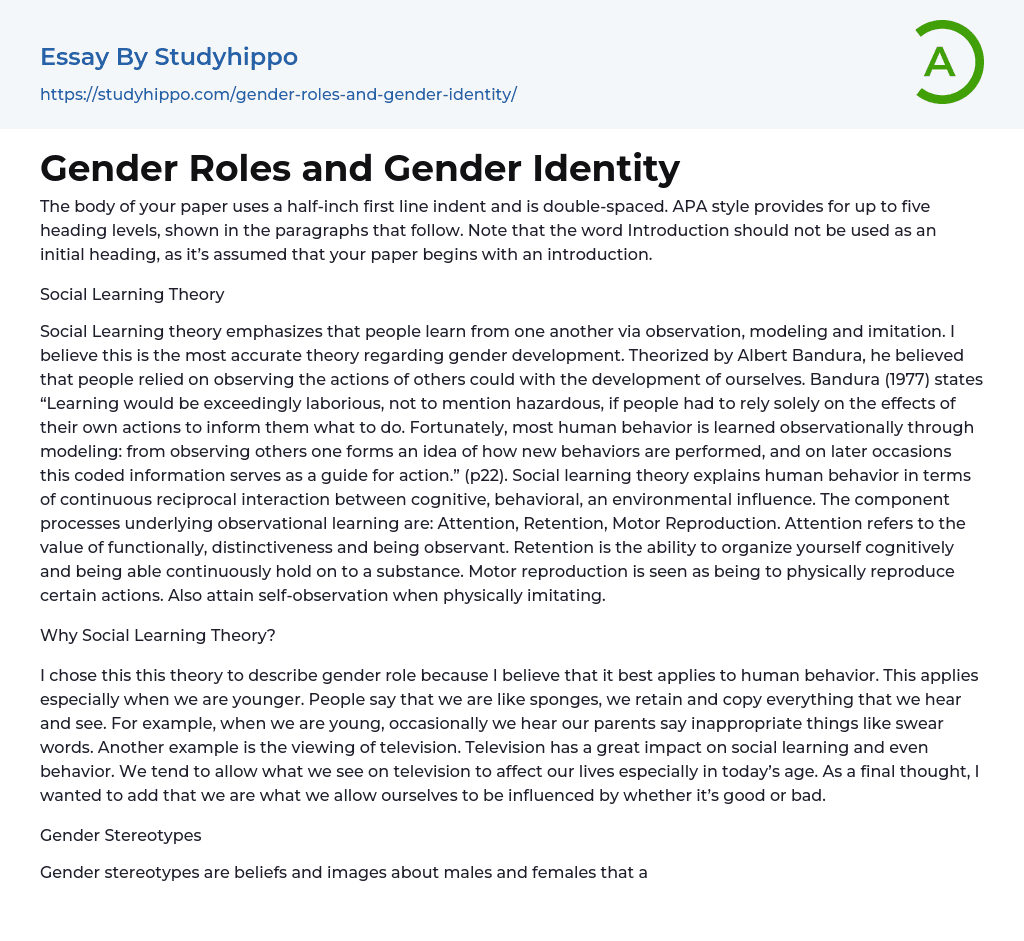The body of your paper uses a half-inch first line indent and is double-spaced. APA style provides for up to five heading levels, shown in the paragraphs that follow. Note that the word Introduction should not be used as an initial heading, as it’s assumed that your paper begins with an introduction.
Social Learning Theory
Social Learning theory emphasizes that people learn from one another via observation, modeling and imitation. I believe this is the most accurate theory regarding gender development. Theorized by Albert Bandura, he believed that people relied on observing the actions of others could with the development of ourselves. Bandura (1977) states “Learning would be exceedingly laborious, not to mention hazardous, if people had to rely solely on the effects of their own actions to inform them what to do. Fortunately, most human behavior is learned observationally through modeling: from observing others one
...forms an idea of how new behaviors are performed, and on later occasions this coded information serves as a guide for action.” (p22). Social learning theory explains human behavior in terms of continuous reciprocal interaction between cognitive, behavioral, an environmental influence. The component processes underlying observational learning are: Attention, Retention, Motor Reproduction. Attention refers to the value of functionally, distinctiveness and being observant. Retention is the ability to organize yourself cognitively and being able continuously hold on to a substance. Motor reproduction is seen as being to physically reproduce certain actions. Also attain self-observation when physically imitating.
Why Social Learning Theory?
I chose this this theory to describe gender role because I believe that it best applies to human behavior. This applies especially when we are younger. People say that we are like sponges
we retain and copy everything that we hear and see. For example, when we are young, occasionally we hear our parents say inappropriate things like swear words. Another example is the viewing of television. Television has a great impact on social learning and even behavior. We tend to allow what we see on television to affect our lives especially in today’s age. As a final thought, I wanted to add that we are what we allow ourselves to be influenced by whether it’s good or bad.
Gender Stereotypes
Gender stereotypes are beliefs and images about males and females that are not necessarily true. For example, men are viewed as competitive and aggressive usually by women. Opposite to that, women are viewed emotional, sensitive and under certain circumstances weak by men. I have not been directly impacted per say, however my youngest brother was impacted by gender stereotype. Growing up, he seemed to have a growing interest in cheerleading and dance. When he came home and told my parents that he had signed up, my father’s immediate reaction was “Isn’t cheerleading for girls? Why would you sign up for that?”. Till this day, my brother still received backlash and is always being stereotyped.
Gender Identity
Gender Identify is defined as the sense of oneself as male or female. According to Lawrence Kohlberg (1966; Kohlberg & Ullian, 1974), full understanding of gender is said to develop gradually in three steps. As toddlers, we know that we are either boy or girl and as such we label ourselves. During preschool years, as children we begin to understand that gender is stable. Boys will become men, and girls will become women. Although we
are aware of our gender stability, we believe that a girl who wears her hair like a boy will become a boy and that a boy who plays with dolls will become a girl. Not until the age of about 5-6 years, do we as children come to realize that maleness and femaleness do not change over situations or according to personal wishes. Once this is understood, we begin learning about gender-type behaviors.
Cultures Influence on Gender Roles, Identity and Stereotypes
Culture shapes the ideas of what behaviors are acceptable for men and women as well as what behaviors are appropriate between men and women. Culture and gender identity share a strong connection as they influence one’s daily life. Though there are variances amongst the different cultures, most have some sort of labor designation that states what tasks or jobs are appropriate for men and women.
- Woman essays
- Boy essays
- Homosexuality essays
- Masculinity essays
- Sexual Orientation essays
- Girl essays
- Man essays
- Lgbt essays
- Gay essays
- Gender essays
- Gender Identity essays
- Transgender essays
- Human Sexual Behavior essays
- Gender Stereotypes essays
- Gender Roles In Society essays
- Suicide In The LGBTQ essays
- Social Construction of Gender essays
- Anthropology essays
- Audience essays
- Charity essays
- Cultural Competence essays
- Emile Durkheim essays
- Gender Roles essays
- Generation essays
- Globalization essays
- Interpersonal Relationship essays
- People essays
- Race essays
- Social Change essays
- Social Class essays
- Social Movement essays
- Social Science essays
- Social Status essays
- Social Stratification essays
- Society essays
- Sociological Imagination essays
- Sociological Perspective essays
- Sociological Theories essays
- Stereotypes essays
- Web Dubois essays




